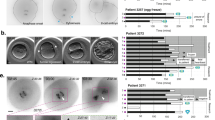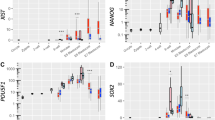Abstract
ALTHOUGH neither X chromosome of preimplantation female mammalian embryos exhibits the two cytological signs of inactivation and dosage compensation—heteropyknosis and late replication1,2—it has not been known whether both X chromosomes actually function during this period. Biochemical evidence based on increasing hypoxanthine-guanine phosphoribosyltransferase (HGPRT) activity during the mouse morula stage indicates that at least one X chromosome is functional3,4. This is corroborated by the observation that mouse embryos lacking an X chromosome do not survive beyond the early cleavage stages5. The principal approach to determining whether both X chromosomes are functional before inactivation has been to look at the distributions of the activities of known X-linked enzymes in individual embryos6,7. A bimodal distribution would be expected if dosage compensation had not yet occurred and female embryos with two X chromosomes made twice as much enzyme as male embryos with only one. However, identities of the embryos being assayed are not known, and conclusions based on activity distributions are necessarily inferential. We have circumvented this difficulty by using a method which facilitates determination of the sex of the embryonic material being assayed. This has led to the demonstration that early male and female mouse blastocysts differ twofold in HGPRT activity, a finding indicative of uncompensated X-chromosome dosage dependent gene activity before X-chromosome inactivation.
This is a preview of subscription content, access via your institution
Access options
Subscribe to this journal
Receive 51 print issues and online access
$199.00 per year
only $3.90 per issue
Buy this article
- Purchase on Springer Link
- Instant access to full article PDF
Prices may be subject to local taxes which are calculated during checkout
Similar content being viewed by others
References
Mukherjee, A. A. Proc. natn. Acad. Sci. U.S.A. 73, 1608–1611 (1976).
Takagi, N. Expl Cell. Res. 86, 127–135 (1974).
Epstein, C. J. J. biol. Chem. 245, 3289–3294 (1970).
Epstein, C. J. Science 175, 1467–1468 (1972).
Tarkowski, A. K. J. Embryol. exp. Morph. 38, 187–202 (1977).
Monk, M. & Kathuria, H. Nature 270, 599–601 (1977).
Adler, D. A., West, J. D. & Chapman, V. M. Nature 267, 838–839 (1977).
Tarkowski, A. K. Nature 184, 1286–1287 (1959).
Kratzer, P. & Gartler, S. M. Nature, 274, 503–504 (1978).
Park, W. W. J. Anat. 91, 369–373 (1957).
Austen, C. R. in The Sex Chromatin (ed. Moore, K. L.) 241–254 (Saunders, Philadelphia, 1963).
Lyon, M. F. Biol. Rev. 47, 1–35 (1972).
Gardner, R. L. & Lyon, M. F. Nature 231, 385–386 (1971).
Monk, M. in Development in Mammals 3, (ed. Johnson, M. H.) (North-Holland, Amsterdam, 1978).
Martin, G. R. et al. Nature 271, 329–333 (1978).
Martin, G. R. Cell 5, 229–243 (1975).
Martin, G. R., Smith, S. & Epstein, C. J. Devl Biol. (in the press).
Epstein, C. J. Science 163, 1078–1079 (1969).
Gartler, S. M. & Andina, R. J. Adv. hum. Genet. 7, 99–140 (1976).
Migeon, B. R. & Jelalian, K. Nature 269, 242–243 (1977).
Lifschytz, E. & Lindsley, D. L. Proc. natn. Acad. Sci. U.S.A. 69, 182–186 (1972).
Epstein, C. J., Wegienka, E. & Smith, C. W. Biochem. Genet. 3, 271–281 (1969).
Golbus, M. S. & Epstein, C. J. Differentiation 2, 143–149 (1974).
Tarkowski, A. K. Cytogenetics 5, 394–400 (1966).
Buckland, R. A., Evans, H. J. & Sumner, A. T. Expl Cell. Res. 69, 231–236 (1971).
Randerath, K. Thin Layer Chromatography 2nd edn, 229–234 (Academic, New York, 1966).
Author information
Authors and Affiliations
Rights and permissions
About this article
Cite this article
EPSTEIN, C., SMITH, S., TRAVIS, B. et al. Both X chromosomes function before visible X-chromosome inactivation in female mouse embryos. Nature 274, 500–503 (1978). https://doi.org/10.1038/274500a0
Received:
Accepted:
Issue Date:
DOI: https://doi.org/10.1038/274500a0
This article is cited by
-
Quantitative and qualitative trophectoderm grading allows for prediction of live birth and gender
Journal of Assisted Reproduction and Genetics (2016)
-
X-chromosome inactivation and escape
Journal of Genetics (2015)
-
X-chromosome inactivation: a hypothesis linking ontogeny and phylogeny
Nature Reviews Genetics (2005)
-
Genetic and parent-of-origin influences on X chromosome choice in Xce heterozygous mice
Mammalian Genome (2005)
-
Transcription of antisense RNA leading to gene silencing and methylation as a novel cause of human genetic disease
Nature Genetics (2003)
Comments
By submitting a comment you agree to abide by our Terms and Community Guidelines. If you find something abusive or that does not comply with our terms or guidelines please flag it as inappropriate.



